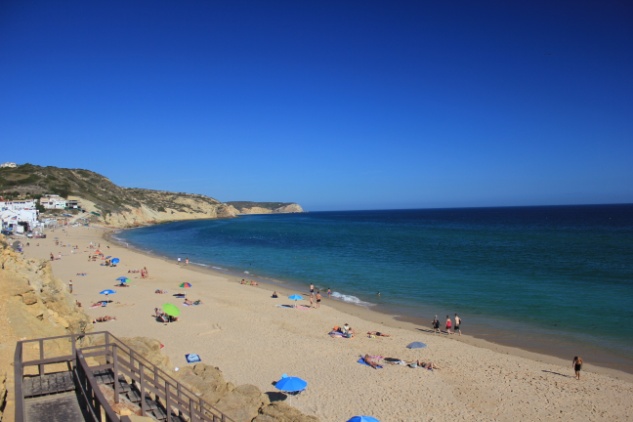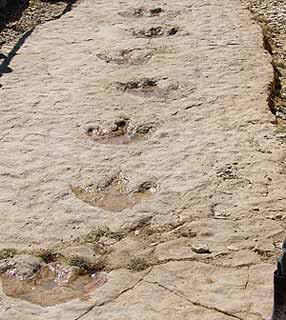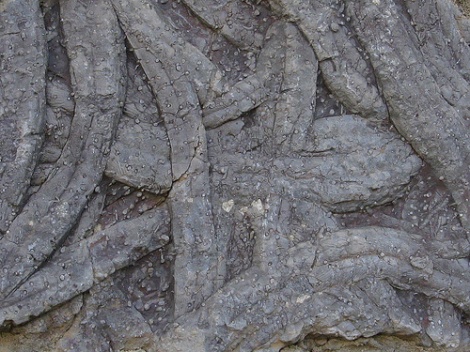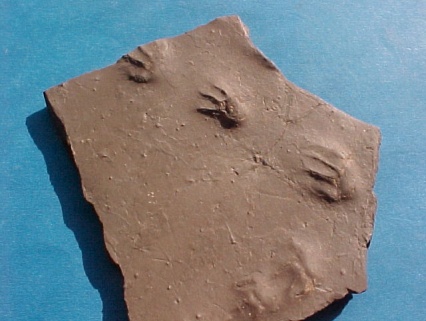
 A praia da Salema apresenta uma das três manchas cretácicas do Algarve ocidental: o afloramento apresenta boa exposição e forma as arribas que delimitam esta praia. As rochas sedimentares da praia da Salema pertencem ao Cretácico inferior, com idade aproximada entre os 145 e os 100 milhões de anos. Esta praia é também um excelente mostruário do ponto de vista estrutural e tectónico. A sequência de camadas sedimentares na zona Oeste da praia apresenta também bons exemplos de bioturbação resultantes da actividade de seres vivos no substrato que correspondia ao fundo oceânico quando estas camadas se formaram. Neste caso trata-se de pistas ou galerias ramificadas com um entrançado tridimensional, horizontal ou oblíquo, atribuíveis a artrópodes. Alguns seres viviam sobre os fundos marinhos, sobre sedimentos arenosos ou lodosos, onde se deslocavam em busca de alimento. Por vezes as marcas da sua actividade impressas nos sedimentos fossilizaram (icnofósseis), originando as pistas de artrópodes que observamos.
A praia da Salema apresenta uma das três manchas cretácicas do Algarve ocidental: o afloramento apresenta boa exposição e forma as arribas que delimitam esta praia. As rochas sedimentares da praia da Salema pertencem ao Cretácico inferior, com idade aproximada entre os 145 e os 100 milhões de anos. Esta praia é também um excelente mostruário do ponto de vista estrutural e tectónico. A sequência de camadas sedimentares na zona Oeste da praia apresenta também bons exemplos de bioturbação resultantes da actividade de seres vivos no substrato que correspondia ao fundo oceânico quando estas camadas se formaram. Neste caso trata-se de pistas ou galerias ramificadas com um entrançado tridimensional, horizontal ou oblíquo, atribuíveis a artrópodes. Alguns seres viviam sobre os fundos marinhos, sobre sedimentos arenosos ou lodosos, onde se deslocavam em busca de alimento. Por vezes as marcas da sua actividade impressas nos sedimentos fossilizaram (icnofósseis), originando as pistas de artrópodes que observamos.
O que são icnofósseis?
Os icnofósseis são definidos como vestígios ou marcas deixadas pela actividade dos seres vivos passados. Do grego ichnós, traço, marca, são icnofósseis as pegadas e outras pistas próprias da locomoção de animais (vertebrados e invertebrados), os ovos fósseis, os coprólitos (excrementos fossilizados) e os gastrólitos (pedras, no geral, boleadas, que o animal ingeria para ajudar a trituração dos alimentação, à semelhança do que se passa com a moela das aves).


A Earthcache
Na base de um bloco caído na praia da Salema podem-se observar pistas de artrópodes resultantes da sua actividade no substrato que correspondia ao fundo oceânico quando estas camadas se formaram. Também se podem verificar pistas de artrópodes na base das camadas da arriba. Estas pistas representam galerias tridimensionais e o seu exterior é caracterizado por uma textura bolbosa, devido ao reforço da estrutura com bolas de sedimento; muitas das observações correspondem a moldes internos. Contudo, e devido à erosão causada pelo mar, estas pistas vão ficando cada vez mais destruídas ao longo do tempo. Para logar esta Earthcache é necessário responder às seguintes perguntas: Qual a forma geométrica que mais se assemelham os trilhos deixados pelos artrópodes? E atendendo a essa forma, qual seria a natureza do fundo ocêanico (rochoso ou arenoso)?

 The Salema's beach has one of three Cretaceous areas of western Algarve: the outcrop reveals a good exposure and forms the cliffs that surround this beach. Sedimentary rocks of Salema's beach belong to the lower Cretaceous, aged approximately between 145 and 100 million years. This beach is also a great showcase of a structural and tectonic point of view. The sequence of sedimentary layers in the west of the beach also presents good examples of bioturbation resulting from the activity of living beings on the substrate corresponding to the seafloor when these layers were formed. In this case are galleries with branching tracks with a three-dimensional braid, horizontal or oblique, attributable to arthropods. Some beings lived on the seabed, on sandy or muddy sediments, where they moved in search of food. Sometimes the marks of their activity printed in sediments fossilized (ichnofossils), yielding clues of arthropods that we can observe.
The Salema's beach has one of three Cretaceous areas of western Algarve: the outcrop reveals a good exposure and forms the cliffs that surround this beach. Sedimentary rocks of Salema's beach belong to the lower Cretaceous, aged approximately between 145 and 100 million years. This beach is also a great showcase of a structural and tectonic point of view. The sequence of sedimentary layers in the west of the beach also presents good examples of bioturbation resulting from the activity of living beings on the substrate corresponding to the seafloor when these layers were formed. In this case are galleries with branching tracks with a three-dimensional braid, horizontal or oblique, attributable to arthropods. Some beings lived on the seabed, on sandy or muddy sediments, where they moved in search of food. Sometimes the marks of their activity printed in sediments fossilized (ichnofossils), yielding clues of arthropods that we can observe.
What are ichnofossils?
 The ichnofossils are defined as traces or marks left by the past activity of living beings. From greek Ichnós, trace, mark, ichnofossils can be footprints and other clues resulted from the locomotion of animals (vertebrates and invertebrates), eggs fossils, coprolites (fossilized dung) and gastroliths (stones, generally rounded, that animals ate to help them to grind the food, similar to what happens with the gizzard of birds).
The ichnofossils are defined as traces or marks left by the past activity of living beings. From greek Ichnós, trace, mark, ichnofossils can be footprints and other clues resulted from the locomotion of animals (vertebrates and invertebrates), eggs fossils, coprolites (fossilized dung) and gastroliths (stones, generally rounded, that animals ate to help them to grind the food, similar to what happens with the gizzard of birds).
The Earthcache
On the basis of a fallen blockin Salema's beach it can observed some arthropod's clues from its activity on the substrate corresponding to the seafloor when these layers were formed. You can also observe arthropods's tracks at the base of the layers of the cliff. These tracks represent three-dimensional galleries and its exterior is characterized by a bulbous texture due to the reinforcement structure with sediment balls; many of the fossils correspond to internal molds. However, due to erosion caused by sea, these tracks are becoming increasingly destroyed over time.
To log this Earthcache you must visit the block with the tracks of arthropods and answer the questions: Which is the geometric form of the tracks? And considering that form, what do you think about the seabed geologic nature (Was it rocky or sandy)?
